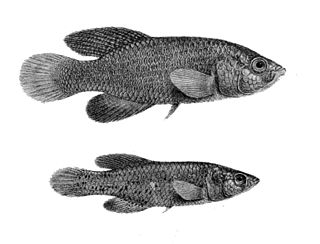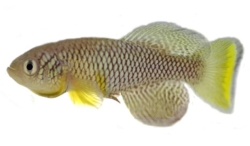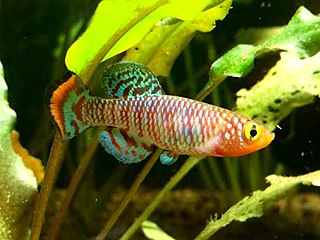
Nothobranchius is a genus of small, freshwater killifish, classified in the family Nothobranchiidae in the order Cyprinodontiformes. There are about a hundred species in the genus, many with very small distributions. They are primarily native to East Africa from Sudan to northern South Africa, whereas a dozen species are found in the upper Congo River Basin; the greatest species richness is in Tanzania.
The elongate nothobranch is a species of killifish in the family Nothobranchiidae. It is endemic to the coastal drainages to the north west of Mombasa in Kenya. Its natural habitat is intermittent freshwater marshes and temporary pools on floodplains.

The Kisaki nothobranch is a species of killifish in the family Nothobranchiidae. It is endemic to Tanzania. Its natural habitat is seasonal pools.

Nothobranchius foerschi is a species of killifish in the family Nothobranchiidae. It is endemic to Tanzania. Its natural habitat is probably temporary pools. The specific name honours the German physician and aquaris Walter Foersch (1932–1993), who was an expert in killifish and was one of the first people to keep and breed this species.
Nothobranchius fuscotaeniatus is a species of killifish in the family Nothobranchiidae. It is endemic to Tanzania.
Nothobranchius geminus is a species of killifish in the family Nothobranchiidae. It is endemic to Tanzania. Its natural habitat is intermittent freshwater pools where it feeds on invertebrates at the surface.

The redtail notho is a species of killifish in the family Nothobranchiidae. It is endemic to Zanzibar. Its natural habitats are intermittent rivers and intermittent freshwater marshes. The redtail notho eats mosquito larvae and other planktonic creatures. Scientists are looking at introducing the species elsewhere in Africa to help with malaria prevention.
Nothobranchius jubbi is a species of killifish in the family Nothobranchiidae. It occurs in north eastern Africa in Kenya, Somalia and Ethiopia in temporary pools, ditches, marshes and rain pans, normally ones without any connections to rivers. This species was described in 1979 by Rudolf Hans Wildekamp and Heinz Otto Berkenkamp with the type locality given as a pool on the road to Garsen, 17 miles north of Malindi. The specific name honours the South African meteorologist and ichthyologist Reginald A. "Rex" Jubb (1905–1987) of the Freshwater Fish Section at the Albany Museum in Grahamstown, South Africa, in recognition of his taxonomic work on the genus Nothobranchius.

Nothobranchius kilomberoensis is a species of killifish in the family Nothobranchiidae. It is endemic to Tanzania where it is found in the floodplain of the Kilombero River where it is found in turbid, seasonal pools.

The spotted killifish is a small, short lived species of fish, an African rivuline from the family Nothobranchiidae. These fish are native to many isolated freshwater pools located in the savannah depressions of east Africa, specifically Malawi, Mozambique, Zimbabwe, and South Africa. This species of fish occurs in ephemeral waters and killifish eggs can survive long periods of dehydration. The word killifish likely comes from the Dutch kil for kill.

Nothobranchius rubripinnis is a species of killifish in the family Nothobranchiidae. It is endemic to Tanzania. Its natural habitats are rivers and rice fields.
Nothobranchius steinforti is a species of killifish in the family Nothobranchiidae. It is endemic to Upper Wami River drainage, Tanzania. Its natural habitat is intermittent freshwater marshes, pools and rice fields. This species was described in 1977 by Rudolf Hans Wildekamp with the type locality given as "8 kilometers from Kimamba, Tanzania". The specific name honours the Dutch aquarist Theo Steinfort who helped collect the type and bred this species in captivity, making it available to other killifish hobbyists.

The Kafue lechwe or Kafue Flats lechwe is a subspecies of the southern lechwe. It is endemic to the Kafue Flats, Zambia. It is listed on the IUCN Red List as vulnerable.

Nothobranchius furzeri, the turquoise killifish, is a species of killifish from the family Nothobranchiidae native to Africa where it is only known from Zimbabwe and Mozambique. This annual killifish inhabits ephemeral pools in semi-arid areas with scarce and erratic precipitations and have adapted to the routine drying of their environment by evolving desiccation-resistant eggs that can remain dormant in the dry mud for one and maybe more years by entering into diapause.

Nothobranchius rachovii, the bluefin notho, is a species of freshwater annual killifish from Mozambique. It can grow up to 6 cm (2.4"). It is popular among killifish enthusiasts, who raise them from eggs in aquaria.

Nothobranchius ditte is a species of brightly colored seasonal killifish in the family Nothobranchiidae, belonging to the Nothobranchius brieni species complex. It is endemic to freshwater habitats in the south-eastern parts of the Democratic Republic of the Congo. Adult males reach a length of about 40–42 mm, but the females are slightly smaller. The species is a semi-annual killifish. They inhabit ephemeral pools filled by rainwater during the monsoon season, being adapted to the alteration of dry and wet seasons. As with all members of the genus Nothobranchius, they show extreme life-history adaptations: their embryos survive by entering a three or four month long diapause, within eggs that have a very hard chorion and are resistant to desiccation and hypoxia. When the habitats dry up, the adult fish die and the eggs survive encased in the clay during the dry season.
Nothobranchius taiti is a species of brightly coloured seasonal killifish in the family Nothobranchiidae. It is endemic to Uganda. It is known from temporary pools and swamps formed on the seasonal floodplains of Apapi River system. The Apapi River is part of the Lake Kyoga basin in the upper Nile drainage in eastern Uganda.
Nothobranchius flagrans is a species of brightly coloured killifish in the family Nothobranchiidae. This species is endemic to south-eastern Democratic Republic of Congo. It is currently known from temporary swamps in the Dikuluwe system in the lower Lufira River drainage.
Nothobranchius chochamandai is a species of seasonal killifish in the family Nothobranchiidae. This species is endemic to south-eastern Democratic Republic of Congo. It is known only from the area of the type locality - ephemeral marshes of the Kinikabwimba River, a tributary of Lufutishi River in the middle Luapula River drainage.
Nothobranchius milvertzi is a species of seasonal killifish in the family Nothobranchiidae. This species is endemic to northern Zambia. It is known only from the area of the type locality - ephemeral pools formed on the floodplain and in the seasonal riverbeds of the Lushiba Marsh in the Lake Mweru basin, Luapula Province, northern Zambia.











